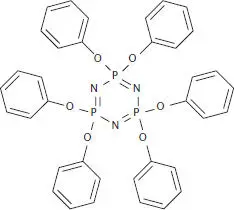(2.39) 
2.11 Environmental Fate and Exposure to Organophosphorus FRs
Tests in pure water, river water, and activated sludge showed that commercial triaryl phosphates, alkyl diphenyl phosphates and aromatic bisphosphates undergo reasonably facile conversion to inorganic phosphates by hydrolysis and biodegradation [434–437]. Due to their low water solubility triaryl phosphates and in particularly TPP are rapidly absorbed into aquatic sediments [438]. Phosphate-cleaving enzymes are widespread in nature. Trialkyl phosphates are more resistant to hydrolysis [439], but they undergo easier photooxidation compared to aromatic phosphates [440]. However, the oxidation can be significantly slowed down if the aliphatic phosphates are absorbed on inert particles [441]. Phosphonates can undergo biodegradation of the P-C bond by certain microorganisms [442, 444]. Proper incineration at 600 - 800°C of flame-retardant plastics or thermosets containing organophosphorus flame retardants leads to quantitative conversion into phosphorus oxides or inorganic phosphates [445, 446], but flame retardants and byproducts of partial decomposition can be emitted in informal open flame recycling [447, 448]. The resultant inorganic phosphates from flame retardants would be orders of magnitude lower than phosphates from agricultural and municipal sources, and thus an inconsequential contributor to algae proliferation. Therefore, it is reasonable to believe that organophosphorus flame retardants and plasticizers cannot be persistent organic pollutants (POP).
However, recent development of more sensitive analytical techniques [449] allows the identification of very low concentrations of organophosphorus compounds in the environment [450, 451]. Some studies analyzed organophosphorus flame retardants in snow [452], rainwater [453] and surface waters [454] and found the highest concentration of thousands of ng/L in urban areas especially close to roads and airports [455] implying that FRs are emitted from the interior of cars and from lubricating oils. Organophosphorus flame retardants were found in Great Lakes atmosphere at levels of hundreds of pg/m 3with the highest concentration close to large cities [456]. A recent study [457] measures the presence of organophosphorus flame retardants in seawater and sediments and despite the relatively low lipophilicity finds bioaccumulation in some marine species. Although organophosphorus FRs are less persistent than organohalogen FRs they still biomagnify in some biological and food nets [458]. Indoor measurements of organophosphorus flame retardants reveal that building insulation and electronic equipment are the main emission sources [459] and in general the concentration is higher in offices than in residential houses. Like brominated FRs, organophosphorus FRs are mostly accumulated in dust [460, 461]. In some work-related environments such as electronic waste recycling facilities [462] or in construction during the application of foam insulation [463] the concentration of specific organophosphorus FRs is elevated. One unexpected route of transfer of organophosphorus FRs from indoors to the environment was suggested to be from clothing to laundry water [464].
A few recent reviews summarized the observed [465, 466] and computed [467] effects of phosphorus flame retardants on human health and the environment. The most concentrated compounds in every study were tris(1-chloro-2-propyl) phosphate (TCPP) and tris(2,3-dichloropryl) phosphate (TDCP) which are chlorinated phosphates and therefore are out of the scope of this chapter. The most common halogen free contaminants are tris(2-butoxyethyl) phosphate and tributyl phosphate which are mostly used as non-flame-retardant plasticizers or leveling agents in floor wax. These phosphates were also found in human urine along with triphenyl phosphate. Triphenyl phosphate is a common impurity in bisphosphates used in electronic and other consumer products [468], but it is also commonly used in nail lacquer. Finding all of these compounds in the environment especially indoors is not surprising because they are relatively volatile [469] and more mobile than most organohalogen FRs [470], whereas heavier and less mobile bisphosphates are very rarely detected in the environment. In general, aliphatic phosphates hydrolyze more slowly than aromatic phosphates and in addition to this TCPP and TDCP are sterically hindered which also slows down their hydrolysis and eventually mineralization [471].
There are many academic studies which erroneously attribute the detection of organophosphates in the environment as being due to the replacement of brominated flame retardants with organophosphorus FRs [472] and call this “regrettable substitution” [473]. This is not correct because chloroaliphatic phosphates, aliphatic phosphates and TPP which are most commonly found in the environment have been in commercial use for a longer time than common halogenated flame retardants. In fact, production of TPP significantly decreased during the last decade. Commercial use of tris(chloroethyl)phosphate (TCEP) was ceased in the USA and Europe about 20 years ago and its occurrence in the environment is sharply decreasing [474]. It is also important to stress that many very low detected concentrations of organophosphorus FRs in the environment are way below the safe threshold for many national regulations. For example, an average 880 ng/kg of body weight daily uptake of organophosphorus FRs found in food [475] is significantly lower than the reference safe dose given by the US EPA (> 5,000 ng/kg). In another study [459] it was found that the daily intake of TCPP from indoor air is only 11% of the tolerably daily intake (TDI) established by the Swiss Federal Health Ministry. Calculated emissions from operating computers is about 50 times lower than the safe suggested concentration by the German Federal Environmental Agency for TCEP, the most toxic organophosphorus FR.
2.12 Conclusions and Further Trends
The growth of phosphorus-based flame retardants as a class is often attributed to the replacement of halogenated flame retardants which is disputable. Although there is a general market trend to halogen-free flame retardants mostly dictated by original equipment manufacturers (OEMs) for their “green image”, there are many areas where halogenated flame retardants cannot be replaced due to technical reasons. Since phosphorus flame retardants possess gas phase and condensed phase modes of flame-retardant action with the gas phase being mostly underutilized there are good prospects for the development of new FRs with mostly gas phase activity or the discovery of new synergistic combinations. Because phosphorus FRs are selectively active in only a handful of highly charrable and heteroatomic polymers there is a need for the development of more universal flame retardants. This research can progress either by development of new highly efficient and hydrolytically stable intumescent systems or of highly efficient gas phase active FRs or of a combination of both. Plastics containing phosphorus FRs are poorly recyclable and so there is interest in more hydrolytically and thermally stable phosphorus flame retardants that are favorable to recycling.
Phosphorus flame retardants have not escaped environmentalist concerns and there are a growing number of academic publications that detect organophosphorus flame retardants in the environment. However, it would be an error to say that phosphorus flame retardants are found more often because they replace halogens. Mostly relatively mobile organophosphorus flame retardants that were detected have been in use for at least half a century. Specific organophosphorus compounds raised sufficient concerns to warrant their discontinuance, but this was not generic to the entire class. Following the general trend of the flame-retardant industry towards polymeric and reactive products which show less negative effects to the final products and minimal exposure to humans and the environment, phosphorus flame retardants will follow this general strategy. Trends in the research and development of phosphorus flame retardants have been in the direction of less volatile, less toxic, and more stable compounds, and where feasible, in the direction of built-in phosphorus structures. At the same time, the existing phosphorus flame retardants are finding increased exploitation in the form of mixtures with synergists and adjuvants.
Читать дальше













